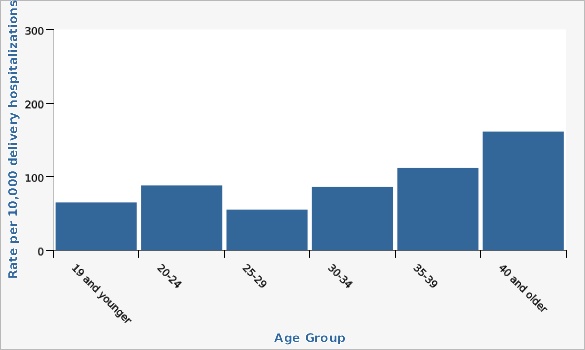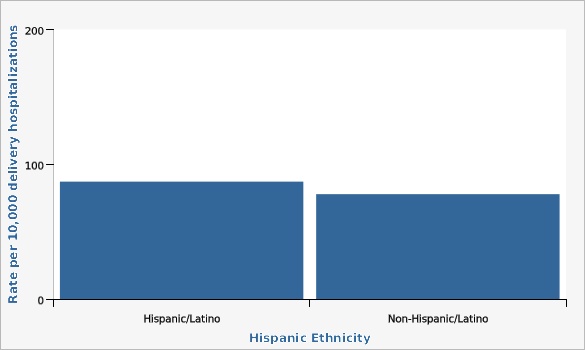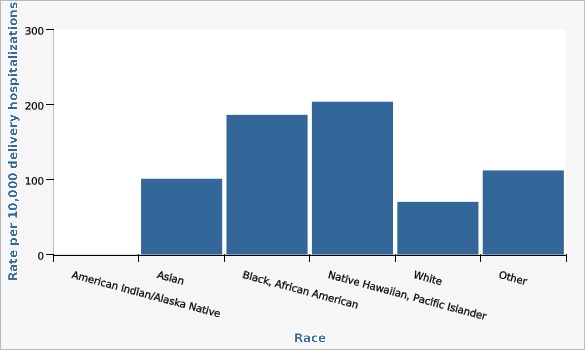Complete Health Indicator Report of Severe maternal morbidity among hospital deliveries
Definition
The number of severe maternal morbidity events per 10,000 delivery hospitalizationsNumerator
The number of deliveries with an identified severe maternal morbidity event from delivery hospitalizationsDenominator
Total number of delivery hospitalizationsData Interpretation Issues
Severe maternal morbidity (SMM) is defined by the Centers for Disease Control and Prevention as "unexpected outcomes of labor and delivery that result in significant short or long-term consequences to a woman's health." SMM is identified using a list of 16 diagnosis and 5 procedure [https://www.cdc.gov/reproductivehealth/maternalinfanthealth/smm/severe-morbidity-ICD.htm ICD codes]. Blood transfusion codes are the most common procedure used to define SMM and some researchers choose to exclude these codes if there are not accompanied by other diagnosis or procedure codes. National and comparative state estimates of SMM are provided by the Healthcare Cost and Utilization Project (HCUP) and do not include transfusions. However, for historical purposes, Utah-specific rates by age group, race, ethnicity, LHD, and payer type do include transfusion codes in defining SMM. Births that occur in freestanding birth centers and private homes are not included in the data. The proportion of Utah births that occur in an out-of-hospital setting was 4% in 2021 and has been increasing over the past several years.Why Is This Important?
Every year, there are approximately 46,000 births to Utah residents. Most births do not result in complications to the mother or child, but some women suffer from "near-misses" or unexpected outcomes during labor and delivery, also called severe maternal morbidities (SMM). These outcomes include hemorrhage, eclampsia, renal failure, acute myocardial infarction, shock, and other severe complications. SMM can have mild to long-lasting effects on the physical and mental health of women experiencing it. Maternal morbidity is also emerging as an important measure in efforts to prevent maternal mortality and address [https://doi.org/10.26099/r43h-vh76 maternal health inequities]. The rate of SMM has been increasing steadily at the [https://datatools.ahrq.gov/hcup-fast-stats/?type=subtab&tab=hcupfsse&count=3 national and state levels]. Specifically, the rate of SMM per 10,000 in-hospital deliveries increased from 71.9 in 2013 to 88.2 in 2020 nationally. Utah has experienced a similar increase with a rate of 48.8 in 2013 and 61.3 in 2020. The comparison of SMM rates between Utah and the U.S. does not include transfusion codes when defining SMM. However for historical purposes, Utah-specific rates by age group, race, ethnicity, LHD, and payer type do include transfusion codes in defining SMM. In addition to the physical and emotional toll SMM has on women and their families, the [https://pubmed.ncbi.nlm.nih.gov/31655962/ financial costs] associated with SMM are significant. Births involving severe maternal morbidity are much more expensive than those without SMM. The [https://www.whitehouse.gov/wp-content/uploads/2022/06/Maternal-Health-Blueprint.pdf White House Blueprint for Addressing the Maternal Health Crisis] calls for supporting state innovation efforts by establishing state-focused Maternal Health Task Forces and improving state-level surveillance on maternal mortality and SMM. Surveillance of SMM in Utah will help health practitioners understand the current state of SMM in Utah, identify risk factors, and develop programs to help prevent severe maternal morbidities.How Do We Compare With the U.S.?
Compared to the U.S. as a whole, the rate of SMM in Utah has historically been lower. However, it has been increasing at both the state and national levels. Currently, Utah ranks 4th in the nation, meaning that Utah has the fourth lowest rate of SMM compared to other states.What Is Being Done?
The Utah Department of Health and Human Services collaborates with the [https://www.saferbirth.org Alliance for Innovation on Maternal Health (AIM)] to prevent severe maternal morbidity and mortality through the use of Patient Safety Bundles in participating facilities. Patient Safety Bundles are evidence-based toolkits meant to improve the processes of care and patient outcomes. Since becoming an AIM participating state, as many as 33 out of 46 birthing facilities in Utah have participated in at least one Safety Bundle, which accounts for approximately 70% of Utah births. Utah birthing facilities have implemented the following Safety Bundles: Obstetric Hemorrhage, Severe Hypertension, and Care for Pregnant Postpartum People with Substance Use Disorders. Utah's Perinatal Mortality Review Committee consists of clinical and public health professionals and meets monthly to review infant and maternal deaths. The Committee reviews de-identified information from death certificates, birth certificates, medical records, autopsy reports, and other resources to determine whether the deaths were preventable. An important goal of the committee is to craft recommendations to prevent future deaths. Recommendations are made at the patient, family, provider, facility, community, and system level to prevent future morbidity and mortality.Available Services
Baby Your Baby Hotline: 1-800-826-9662[[br]] [https://babyyourbaby.org/ https://babyyourbaby.org/] [[br]]A resource to answer pregnancy related questions and locate services for the public. Power Your Life website: [http://www.poweryourlife.org] [[br]]Public education promoting optimal health prior to pregnancy. Social media for Power Your Life include: [[br]]Facebook: [http://www.facebook.com/poweryourlifeut http://www.facebook.com/poweryourlifeut] [[br]]Twitter: @Poweryourlife2 [[br]]TInstagram: @Poweryourlifeut Utah Tobacco Quit Line: 1-888-567-8788 MotherToBaby Utah: [[br]]Phone - 1-800-822-2229 [[br]]Text - 1-855-999-3525 [[br]]Email - expertinfo@mothertobaby.org [[br]]A service to answer questions about what medications are safe during pregnancy and breastfeeding. Social media for MotherToBaby include: [[br]]Facebook: [http://www.facebook.com/MotherToBaby] [[br]]Twitter: @MotherToBaby [[br]]Pinterest: [http://www.pinterest.com/MotherToBaby] Utah Women and Newborn Quality Collaborative: [https://mihp.utah.gov/uwnqc] [[br]]Provider and patient education to improve maternal and neonatal outcomes. March of Dimes: [http://www.marchofdimes.org] [[br]]The mission of the March of Dimes is to improve the health of babies by preventing birth defects, premature birth and infant mortality. [[br]]Social media for March of Dimes include: [[br]]Facebook: [https://www.facebook.com/marchofdimes] [[br]]Twitter: @MarchofDimes [[br]]YouTube: [https://www.youtube.com/marchofdimes] University of Utah Health Care Parent-to-Parent Support Group: 1-801-581-2098 [[br]]Support Program for families of high risk/critically ill newborns. Share Parents of Utah: A support program for families experiencing pregnancy loss or death of an infant[[br]] 801-272-5355 [[br]][http://sputah.org/] Find providers trained in perinatal mental health based on provider type, location or insurance accepted at [https://maternalmentalhealth.utah.gov/]. Postpartum Support International - Utah provides extensive resources for maternal mental health. [[br]]Visit their website at [https://www.psiutah.org/]. St. Mark's Hospital offers an intensive outpatient program for the treatment of perinatal mood disorders. [[br]]More information is available at [https://stmarkshospital.com/service/perinatal-outpatient-program]. The University of Utah SUPeRAD clinic specializes in care for pregnant women with substance addictions. [[br]]Call 801-581-8425 for more information. To find local substance use disorder and mental health treatment options, visit [https://sumh.utah.gov].Related Indicators
Related Relevant Population Characteristics Indicators:
Related Health Care System Factors Indicators:
Risk Factors
There are racial and ethnic disparities in rates of SMM in Utah, with Hawaiian/Pacific Islander, African American/Black, Native American/Alaska Native, Asian, and Hispanic women having higher rates of SMM compared to non-Hispanic White women. Individuals living in rural areas also experience higher rates of SMM, compared to those in urban locations. [https://www.ajogmfm.org/article/S2589-9333(19)30106-5/fulltext#:~:text=Prepregnancy%20overweight%20and%20obesity%2C%20advanced,associated%20with%20severe%20maternal%20morbidit Other characteristics associated with higher rates of SMM] include older maternal age, being overweight or obese, experiencing excessive or inadequate gestational weight gain, pre-existing conditions such as hypertension and diabetes, having six or more prior births, and individuals who deliver very preterm (at 32 weeks gestation or earlier).Graphical Data Views
Severe maternal morbidity among hospital deliveries by year, Utah and U.S. 2020-2021 (does not include transfusion codes)
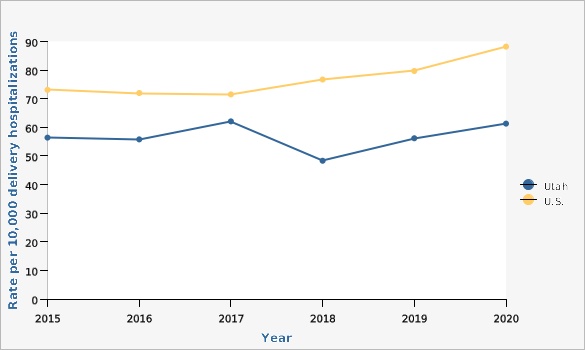
| Utah vs. U.S. | Year | Rate per 10,000 delivery hospitalizations | ||||
|---|---|---|---|---|---|---|
Record Count: 12 | ||||||
| Utah | 2015 | 56.4 | ||||
| Utah | 2016 | 55.8 | ||||
| Utah | 2017 | 62.1 | ||||
| Utah | 2018 | 48.3 | ||||
| Utah | 2019 | 56.2 | ||||
| Utah | 2020 | 61.3 | ||||
| U.S. | 2015 | 73.1 | ||||
| U.S. | 2016 | 72.0 | ||||
| U.S. | 2017 | 71.5 | ||||
| U.S. | 2018 | 76.7 | ||||
| U.S. | 2019 | 79.7 | ||||
| U.S. | 2020 | 88.2 | ||||
Data Notes
The comparison of SMM rates between Utah and the U.S. does not include transfusion codes. This is due to the way HCUP defines SMM.Data Source
Healthcare Cost and Utilization Project (HCUP), AHRQ| Age Group | Rate per 10,000 delivery hospitalizations | Lower Limit | Upper Limit | |||
|---|---|---|---|---|---|---|
Record Count: 6 | ||||||
| 19 and younger | 65.0 | 37.9 | 104.1 | |||
| 20-24 | 88.1 | 74.8 | 103.0 | |||
| 25-29 | 55.1 | 47.2 | 64.0 | |||
| 30-34 | 86.0 | 74.7 | 98.5 | |||
| 35-39 | 111.8 | 93.0 | 133.3 | |||
| 40 and older | 161.2 | 115.2 | 219.5 | |||
Data Notes
Includes transfusion codesData Source
Utah Inpatient Hospital Discharge Data, Healthcare Information & Analysis Programs, Office of Research & Evaluation, Utah Department of Health and Human Services| Hispanic Ethnicity | Rate per 10,000 delivery hospitalizations | Lower Limit | Upper Limit | |||
|---|---|---|---|---|---|---|
Record Count: 2 | ||||||
| Hispanic/Latino | 87.1 | 72.5 | 103.8 | |||
| Non-Hispanic/Latino | 77.8 | 71.5 | 84.2 | |||
Data Notes
Includes transfusion codes Race/ethnicity is self-reported during the intake/admission process. Anyone of any race can also have Hispanic/Latino ethnicity.Data Source
Utah Inpatient Hospital Discharge Data, Healthcare Information & Analysis Programs, Office of Research & Evaluation, Utah Department of Health and Human Services| Race | Rate per 10,000 delivery hospitalizations | Lower Limit | Upper Limit | |||
|---|---|---|---|---|---|---|
Record Count: 6 | ||||||
| American Indian/Alaska Native | ** | |||||
| Asian | 101.0 | 63.3 | 152.9 | |||
| Black, African American | 186.2 | 122.7 | 270.9 | |||
| Native Hawaiian, Pacific Islander | 203.7 | 142.7 | 282.1 | |||
| White | 70.2 | 64.2 | 76.2 | |||
| Other | 112.1 | 91.4 | 136.0 | |||
Data Notes
Includes transfusion codes Race/ethnicity is self-reported during the intake/admission process. Anyone of any race can also have Hispanic/Latino ethnicity. **The estimate has been suppressed because 1) the relative standard error is greater than 50% or the relative standard error can't be determined; 2) the observed number of events is very small and not appropriate for publication; or 3) it could be used to calculate the number in a cell that has been suppressed.Data Source
Utah Inpatient Hospital Discharge Data, Healthcare Information & Analysis Programs, Office of Research & Evaluation, Utah Department of Health and Human ServicesSevere maternal morbidity among hospital deliveries by local health district residence of mother 2020-2021
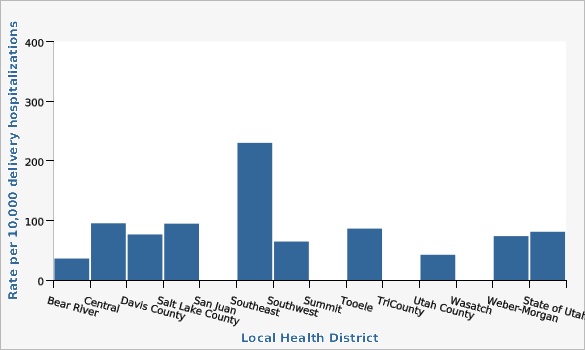
| Local Health District | Rate per 10,000 delivery hospitalizations | Lower Limit | Upper Limit | |||
|---|---|---|---|---|---|---|
Record Count: 14 | ||||||
| Bear River | 36.0 | 22.0 | 55.6 | |||
| Central | 95.1 | 55.4 | 152.3 | |||
| Davis County | 76.4 | 58.4 | 98.1 | |||
| Salt Lake County | 94.5 | 82.0 | 108.5 | |||
| San Juan | ** | |||||
| Southeast | 230.0 | 138.5 | 359.2 | |||
| Southwest | 64.5 | 45.9 | 88.2 | |||
| Summit | ** | |||||
| Tooele | 86.2 | 49.3 | 140.0 | |||
| TriCounty | ** | |||||
| Utah County | 42.3 | 34.1 | 51.9 | |||
| Wasatch | ** | |||||
| Weber-Morgan | 73.6 | 55.0 | 96.6 | |||
| State of Utah | 80.9 | 75.0 | 86.8 | |||
Data Notes
Includes transfusion codes **The estimate has been suppressed because 1) The relative standard error is greater than 50% or the relative standard error can't be determined; 2) the observed number of events is very small and not appropriate for publication; or 3) it could be used to calculate the number in a cell that has been suppressed.Data Source
Utah Inpatient Hospital Discharge Data, Healthcare Information & Analysis Programs, Office of Research & Evaluation, Utah Department of Health and Human Services| Health Insurance Plan Type | Rate per 10,000 delivery hospitalizations | Lower Limit | Upper Limit | |||
|---|---|---|---|---|---|---|
Record Count: 3 | ||||||
| Private/employer coverage | 72.6 | 66.6 | 78.6 | |||
| Medicaid | 138.6 | 114.7 | 166.0 | |||
| Some other insurance coverage | 108.4 | 76.3 | 149.4 | |||
Data Notes
Includes transfusion codesData Source
Utah Inpatient Hospital Discharge Data, Healthcare Information & Analysis Programs, Office of Research & Evaluation, Utah Department of Health and Human ServicesReferences and Community Resources
Data for this indicator comes from the Healthcare Facility Database housed in the Office of Health Care Statistics in the Division of Data Systems and Evaluation of the Utah Department of Health and Human Services. The Healthcare Facility Database contains encounters in Utah records for all licensed hospitals, emergency rooms, and ambulatory surgery centers.More Resources and Links
Evidence-based community health improvement ideas and interventions may be found at the following sites:- Centers for Disease Control and Prevention (CDC) WONDER Database, a system for disseminating public health data and information.
- United States Census Bureau data dashboard.
- Utah healthy Places Index, evidence-based and peer-reviewed tool, supports efforts to prioritize equitable community investments, develop critical programs and policies across the state, and much more.
- County Health Rankings
- Kaiser Family Foundation's StateHealthFacts.org
- Medical literature can be queried at PubMed library.
Page Content Updated On 10/26/2023,
Published on 01/12/2024

